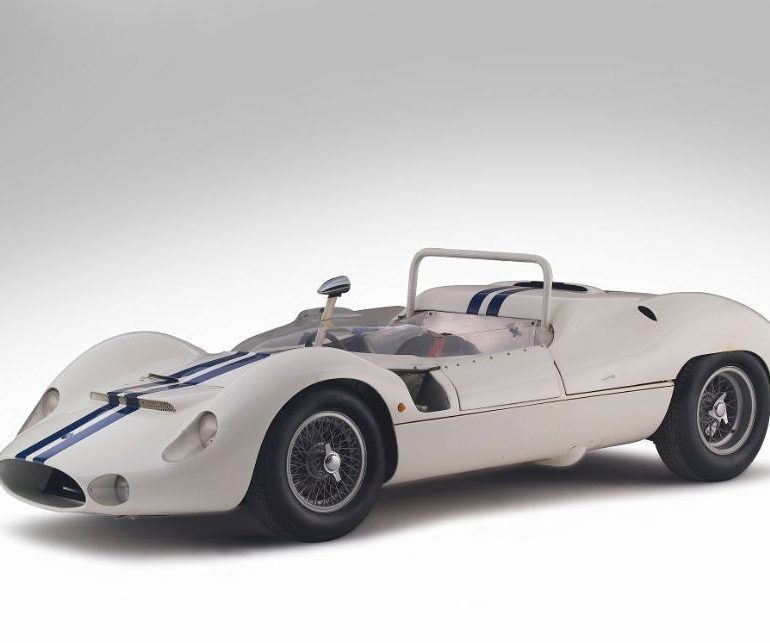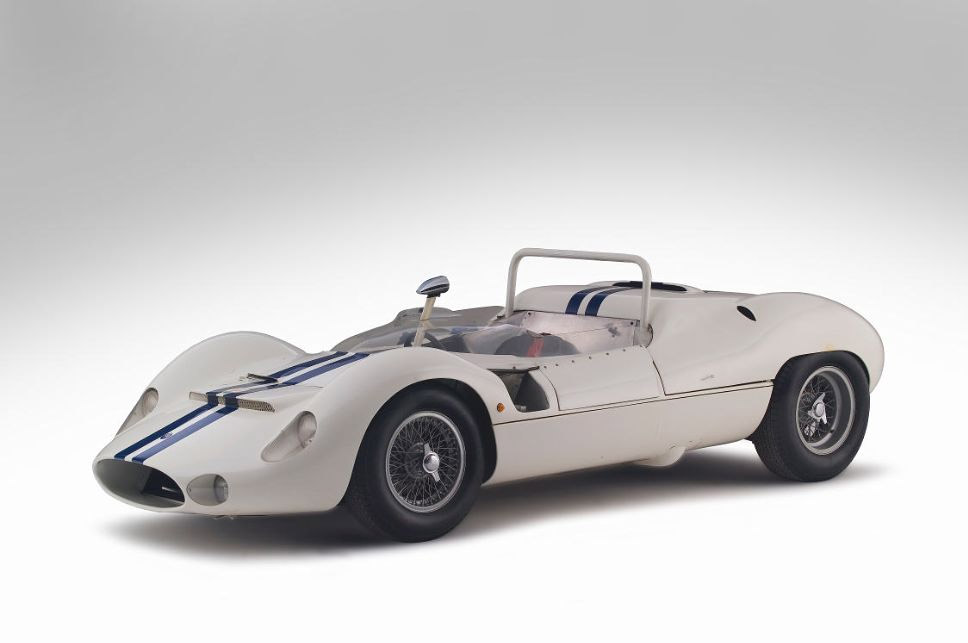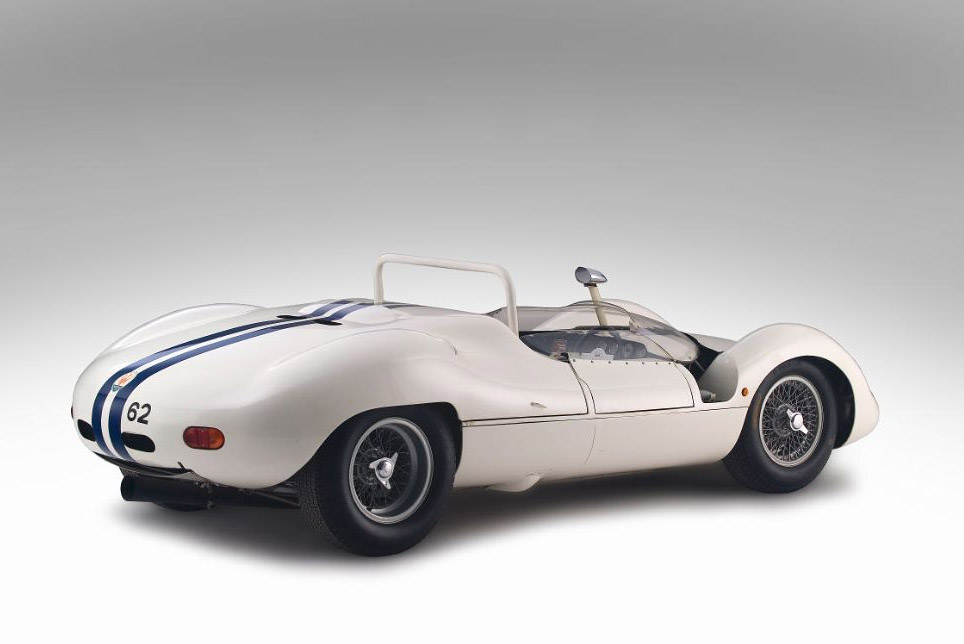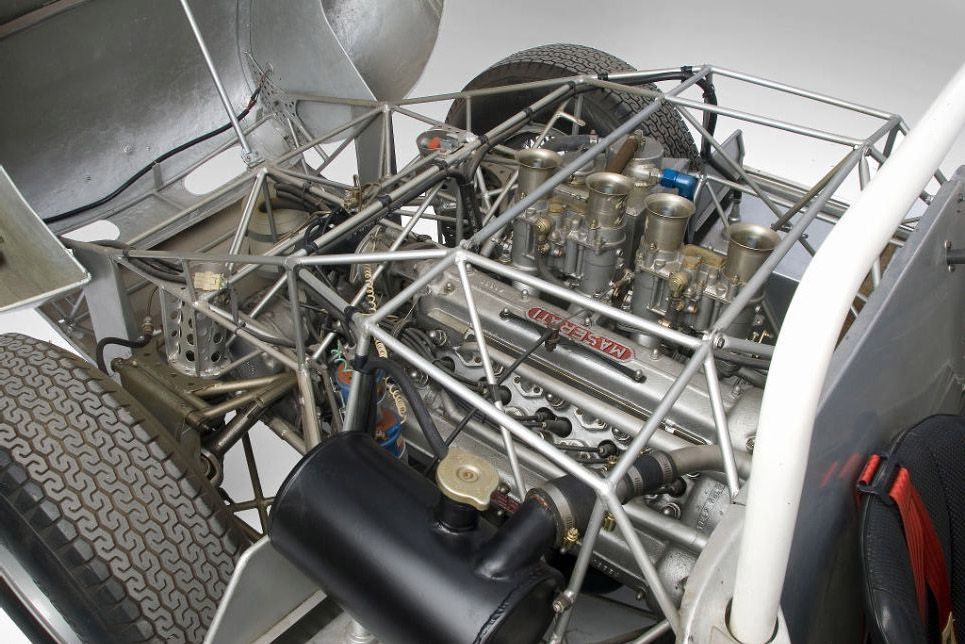1961 Maserati Tipo 63
The Tipo 63 took Maserati’s sports racecar from Birdcage to Supercage. That is, from a front-engine, four-banger into a screaming sports racer with a V12 behind the driver. This transition took place over the 1961 season with rapid development that often changed specification from race to race. This hastiness led to some mechanical failure, but a few outstanding victories were scored.
Like every manufacturer making the leap from front to mid engine, Maserati’s engineers found great difficulty in balancing the weight distribution. Furthermore, issues of making room for rear transaxles and maintaining reliability were even more difficult. These factors made the Tipo 63 somewhat less successful than the old Tipo 61 Birdcage it replaced.
Muletto.
Maserati began testing the new mid-engine Tipo 63 Muletto in December of 1960. This car wasn’t entirely new. Instead it was an economical transformation of the front-engine Tipo 61. Both designed by Giulio Alfieri, they used the same principle for their chassis including a complex network of thin tubes to support the running gear and aluminum body. Due to a limited budget, the Tipo 63 also used many of the Birdcage’s components including a similar transmission and the four cylinder engine instead of a preferred V8.² This engine cylinder was canted an angle of 58 degrees in the chassis to accommodate downdraft 48 IDM Webers instead of smaller side-draft versions. This helped produce 15 more horsepower, reaching 265 bhp.
To fit the new transaxles, Tipo 63 chassis were all new at the rear. The bulky de Dion suspension was replaced by double wishbones and half shafts to help with weight distribution. Furthermore, twin 60 liter fuel tanks were relocated into the side sills.
Initial tests of the bare-aluminum Muletto prototype were unfavorable and it was criticized for being too short. Fortunately, Maserati persisted and begin production of the first three Tipo 63s to stay competitive with the other mid-engine sports cars like the Ferrari 246SP, Lotus 19 and Cooper Monaco.
1961 Season: from 4 to 12 cylinders.
In an effort to keep make the Tipo 63 competitive, Maserati was constantly making radical changes throughout the season to make it faster than the older Tipo 61. Remarkably, the initial chassis and engine configurations in 1961 were unsuccessful, so much so they were scrapped for parts later in the season. This was probably due to the reliance on an old engine design and a complex chassis that was overly flexible.
Alongside a few of the front-engine Tipo 61s which were still very competitive, three teams contested the Tipo 63 Maserati in 1961. These three were Count Volpi’s Scuderia Serenissima, Lucky Casner’s Camoradi team and Briggs Cunningham. Each spent considerable time developing the cars for the European World Sports Car Championship (WSCC) which opened at the 12 Hours of Sebring.
The Tipo 63’s race debut at Sebring ended with rear suspension and transaxle failure for both cars. Immediately the new Tipo 63 proved to be too complex and unforgiving. As an example, to comply with minimum windscreen regulations Maserati fitted a long, nearly horizontal, Plexiglas front windscreen which was tough to see out of or over. Furthermore, flex in the chassis combined with a heavily-vibrating engine caused too many problems. Most drivers, including Stirling Moss, immediately preferred the more balanced Tipo 61. Maserati needed change.
At the second WSCC round at the Targa Florio, Maserati debuted two new cars for Scuderia Serenissima, one lacking the usual roll-bar. Both featured longer, more protruding noses and Dunlop disc wheels. One of these was specially built with a 50mm longer wheel base (LWB) to help with handling and it proved to be much faster. Both cars showed uncharacteristic reliability and finished fourth and fifth overall.
Nurburgring 1000km was a surprising success for Camoradi’s Maserati, but only for the old Tipo 61 driven by team boss Lucky Casner and Masten Gregory. Two Tipo 63s had their long-sloping Plexiglas windscreens replaced by glass counterparts from the Alfa Romeo Sprint Speciale. One retired with a transaxle crack while the other finished 23rd overall.
V12 for LeMans
The sole LWB birdcage from Targa Florio was actually a segueway to introduce a V12 engine that would need the additional space. Extra horsepower was greatly needed for the faster tracks like Sebring and Le Mans. Furthermore, the smoother V12 didn’t rattle the rear end to oblivion like the four bangers. In this configuration, Maserati was the first to install a mid-ship V12 in a sports car, beating Ferrari’s 250P by two years.
Maserati used a version of the V12 that was developed for the 1957 250F T2 in Formula 1.² To endure the torture of a long distance race, drivers kept to 8500 rpm even though 10,000 rpm was used in F1. For Le Mans, all three cars were equipped with a V12, but each with a slightly different bore and stroke that varied output from 310 to 320 bhp. Only Cunningham received a LWB V12, while the other two cars were converted from old SWB chassis and suffered from cramped cockpits. All three had a new and characteristic quad megaphone exhaust protruding out from the rear engine deck. Unfortunately the new V12 had a terrible front to weight distribution of as/12.
In practice, Cunningham’s new LWB Tipo 63 was only one second off pace with top running Ferrari. The new engine raised top speed from 162 mph (260 kph) to 193 mph (312 kph). Unfortunately, the Cunningham car crashed during the race in fourth place after leaking oil over its windscreen. Fortunately, one of the SWB cars managed to finish the race in fourth overall, but only after three lengthy spark plug replacements, needing 24 new plugs that were obscured by small engine openings and burning hot exhaust pipes.
After Ferrari clinched the Manufacturer’s Championship at Le Mans, Maserati went back to drawing board yet again. They changed the rear engine deck to a one-piece design that could pivot from the rear. Furthermore, the exhausts were relocated underneath the body and larger front radiators were fitted requiring front air scoops. The third and final LWB Tipo 63 initially was built in this ultimate specification.
End Season
Having only achieved one fourth place in the WSCC, two Tipo 63s were shipped to America to compete in SCCA and USAC races by Cunningham. The results were much more favorable than in Europe: Walt Hansgen won both Bridgehampton and the Road America 500 driving Tipo 63s. When combined with his Birdcage victories, he missed the SCCA Driver’s Championship by just two points. Later in the year, the west coast USAC races had considerably more competition, but the Cunningham team retired six engines in just three races.
At the end of the season a total of seven Tipo 63 chassis were constructed. The Muletto, three SWB cars (two were upgraded with V12s for Le Mans) and three LWB cars were made (two with V12s). Throughout 1961 some chassis numbers were swapped and old chassis scrapped to avoid taxes.
Although the Tipo 63 almost always held a top position before retiring, the fact that it won at all is remarkable. 1961 was very much a development year for Maserati and had they entered more cars with more testing, more victories could have been won.
For the 1962 season it was apparent Maserati needed something new to stay competitive in the US and Europe. The Tipo 64 was drafted up as a much smaller car with revised de Dion suspension and further upgrades.
Our feature car, chassis 63.010 was the most successful Tipo 63, having won two SCCA races for Briggs Cunningham. It was sold in 1965 as an engineless car and was fitted with a Ford V8 engine. Later, it was bought by Peter Kaus and fitted with an incorrect 2.4-liter four-cylinder Maserati engine from a power boat for his Rosso Bianco collection.
In Detail
| tags | birdcage |
| submitted by | Richard Owen |
| type | Series Production Car |
| production | 7 |
| price $ | $ 9,500 |
| engine | 250F T2 V12 |
| position | Mid-Longitudinal |
| aspiration | Natural |
| valvetrain | DOHC, 2 Valves per Cylinder |
| fuel feed | 6 Weber 35DCV Carburettors |
| displacement | 2989 cc / 182.4 in³ |
| bore | 70.4 mm / 2.77 in |
| stroke | 64 mm / 3.62 in |
| compression | 10.0:1 |
| power | 231.2 kw / 310 bhp @ 8200 rpm |
| specific output | 103.71 bhp per litre |
| bhp/weight | 400.0 bhp per tonne |
| body / frame | Aluminum Body over Tubular Steel Spaceframe |
| driven wheels | RWD |
| wheel type | 16 Inch Borrani or Alloy Discs |
| front tires | 6.00×16 Dunlop |
| rear tires | 6.50×16 Dunlop |
| front brakes | Girling Discs |
| rear brakes | Girling Discs |
| front wheels | F 40.6 x 11.4 cm / 16 x 4.5 in |
| rear wheels | R 40.6 x 11.4 cm / 16 x 4.5 in |
| steering | Rack & Pinion |
| f suspension | Double Wishbones w/Coil Springs, Koni Telescopic Dampers, Anti-Roll Bar |
| r suspension | De Dion Type Axle w/Transverse Leaf Springs, Telescopic Koni Dampers, Anti-Roll Bar |
| curb weight | 775 kg / 1709 lbs |
| weight distro | 43 % / 57 % |
| top speed | ~312 kph / 193.9 mph |
| fuel capacity | 120 litres or 31.68 gal. |







